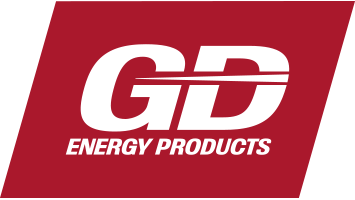Avoid unexpected downtime and catastrophic failures by developing a proactive maintenance schedule designed to suit your unique operations.
Performance of periodic routine maintenance tasks will ensure long, economical, and trouble-free operation of your pump. GD Energy Products (GDEP) recommends that you set up a maintenance program during the mechanical run-in period, when the pump’s moving parts work alongside each other under sustained normal operating conditions for the first time, stabilizing their final working positions. The periodic maintenance schedule should be divided into daily, monthly, quarterly, and semi-annual tasks to be performed by the user after the pump has gone through the mechanical run-in period.
Daily Routine Maintenance Tasks
- Check oil level in lube oil reservoir.
- Monitor lube oil operating pressure and temperature periodically. Minimum oil operating pressure is 70 psi at the pump inlet. The maximum oil operating temperature depends on the particular grade of oil used in the pump lube system.
- Check the lube pump suction inlet vacuum. A vacuum gage reading higher than 8" Hg or 4 psi or 0.28 bar indicates that the suction strainer and/or oil suction filter element is clogged. The strainer must be cleaned, and/or the filter element replaced as necessary, as soon as the pump can be shut down for a short period of time to perform these tasks.
- Check the pressure gauge ahead of filter: if it is close to the filter bypass setting, the filter is becoming clogged and the oil filter element should be replaced as soon as the pump can be shut down for a short period of time to perform the task. If the filter is already on bypass, the pump should be shut down immediately and the filter element replaced.
- Listen for any abnormal noise or rough operation, which may indicate the need for fluid end maintenance such as changing valves or valve seats. Due to very high pressures in the fluid end, worn valves and seats should be changed as soon as possible to prevent erosion from the pumped fluid.
- Check the plunger/packing lubrication pump for proper operation. Ensure packing nut is tightened sufficiently into fluid cylinder. Recheck tightness after extended continuous operation.
Monthly (100 hour) Routine Maintenance Tasks
- Clean the strainer and replace the oil filter element.
- Check the entire lube system for leaks and eliminate them.
- Check all fluid end expendables such as valves, packing, and valve seats and replace them as necessary.
- Check the power end extension rod seals and replace them as necessary.
Quarterly (300 hour) Routine Maintenance Tasks
- Clean the lube system strainer and replace the oil filter elements.
- Re-tighten the critical bolt joints following torque specifications given in if found defective.
- Treat any exposed bare metal to prevent corrosion.
- Clean or replace the breather cap filter element.
- Check all pressure, temperature, and vacuum gauges for proper operation and replace as necessary.
- Check all lube system warning and alarm devices for proper operation and replace if found defective.
- Check supply of on-hand expendables such as packing, valves and seats, maintenance items such as seals, O-rings, oil and breather filter elements, and also maintenance tools. Order to replenish supplies as necessary.
Every 1500 Hours Routine Maintenance Tasks
- Remove connecting rod caps and inspect journal bearings. Front and back half of bearings are identical parts, but the front should wear out faster than the rear. Replace if any signs of the following are present on either: excessive heat/burning, deep and excessive scoring or heavy wear/thin cross-section, bearing material missing, spalling, and redistribution of bearing material.
- Inspect crankshaft throws for similar signs of excessive wear, heat, deep grooves, and damage.
- Inspect what can be seen of the main bearings, frame, etc. for abnormal signs of damage, debris, etc.
Need Help?
As you perform these maintenance tasks and an unknown problem with your pumps arise, our service technicians can be dispatched to your jobsite anywhere in the world. Our experts are able to deploy advanced troubleshooting measures, uncover the issue and repair onsite. From power and fluid end inspections and repairs, to hands-on training: we have you covered.
Major Repair
It is highly recommended that the pump be moved to a machine shop if major repair is required. GDEP’s certified state-of-the-art repair shops and service facilities, which are located in every major shale play across North America, operate in a constant state of readiness to provide your pumps with the most efficient, comprehensive and cutting-edge repair and maintenance services in the industry. Backed by our satisfaction guarantee, you can have the confidence your pumps will operate at peak performance after it leaves our facility.
No time? Exchange It Out
When there’s no time for downtime, we can exchange your power end out and ship a new one the next day. Whether you have a GDEP frac pump, or a different one, provide us with your power end and we will exchange it for one that has been perfectly manufactured with OEM parts, fully tested and even painted to your specification.
Learn More


